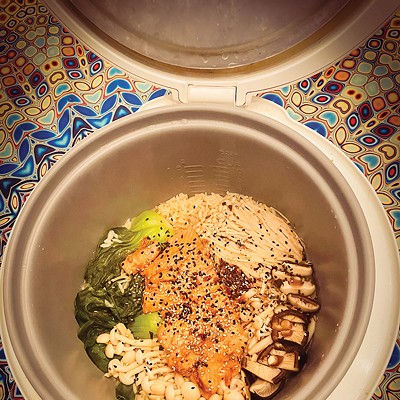Though I don't have any Slavic or Orthodox Christian roots, my family has been making a rich cheese-based dessert called paskha every Easter for decades. Paskha is a traditional Eastern Orthodox dish resembling a crustless cheesecake. It is served after the "breaking of the fast" at the end of Lent. We first read about paskha when we were in college in the 1969 Time-Life Foods of the World cookbook series and it has been an Easter tradition in the Glatz household ever since.
My late wife and former Illinois Times food columnist, Julianne, wrote about paskha in her IT column in 2011. In her recipe notes, she wrote that paskha was traditionally made with farmer cheese, which she wasn't able to find, so she substituted whole-milk ricotta. Paskha is usually made in a decorative truncated pyramid-shaped mold called a pasotchnitza, which she was also unable to locate, so she made her paskha in an inverted flowerpot. My family loves the ricotta version, but I wondered if a more authentic version made with farmer cheese would be superior, so I set to work to find out.
It got confusing when it came to terminology. I did a Google search and found out that paskha (with a "k") is the Ukrainian Easter cheese dish. Paska (with the "k" but without the "h") is a Ukrainian sweet yeast bread, studded with nuts and raisins, also known as kulich. It gets even more confusing: Pascha (with a "c" and "h" but without a "k") is the Eastern Orthodox name for Easter, which is celebrated on May 5 this year, as opposed to our Western Easter which falls on March 31. Paskha (the cheese) is traditionally spread on paska (the bread) to be served on Pascha (the holiday). Both the paskha and the paska are taken to church before Pascha, to be blessed by the priest. Confusing? You bet!
For the 40 days preceding the Eastern Orthodox Easter, the consumption of meat, eggs, butter or other dairy products is forbidden. On Easter Sunday, when the fast has ended, followers are again allowed to eat these "forbidden" ingredients and this is why many of the Easter dishes contain eggs, butter, cheese and cream. Making paskha was a way of using up all the eggs and dairy products that had accumulated during the fast.
Paskha molds are traditionally made from wood and can be quite expensive, but I was able to find a plastic pasotchnitza on Amazon for less than $10. The elusive Ukrainian farmer cheese took a bit more of a hunt. It is known as tvorog and it has a texture that is somewhat drier than American cottage cheese and a flavor that is somewhat tangy like a mild chevre. Tvorog is eaten as a breakfast cheese with sweet accompaniments like jam and honey. I was very excited to learn that Prairie Fruits Farm and Creamery in Champaign employs a Ukrainian cheesemaker, Tetyana Dyadechko, who has been making authentic Ukrainian farmer cheese from Kilgus Farmstead Jersey cow milk. I got up early on a Saturday morning to drive to the Champaign-Urbana Winter Farmers Market to buy Prairie Fruits Ukrainian Farmers Cheese to use for my paskha; only later did I discover that Springfield's Food Fantasies sells Ukrainian-style farmer cheese made by Lifeway, an American kefir company founded by Michael Smolyansky, a Ukrainian Jewish immigrant.
Paskha
8-10 servings
Depending on the size of your mold, you may have extra paskha mixture. If so, line a mesh strainer with more cheesecloth and spoon in the remaining mixture to make a second smaller paskha.
Ingredients:
2 pounds fresh farmer cheese, room temperature
3 sticks unsalted butter, room temperature
1 cup heavy cream
6 egg yolks, room temperature
1 ½ cups sugar
¼ teaspoon grated fresh nutmeg
Zest of 1 orange
1/2 cup coarsely chopped almonds
1/2 cup golden raisins
1 vanilla bean, seeds scraped out
For decorating (optional):
Toasted nuts
Sliced or chopped fresh or candied fruit, for garnish
Also needed:
Cheesecloth
Paskha mold (pasotchnitza) or a clean 6-inch flower pot
Preparation:
Press the farmer cheese through a sieve or food mill and set aside.
Melt the butter and let it cool down thoroughly. When cool, combine with the cheese.
Heat the cream in a heavy pan until small bubbles start to form around edge of the pan.
In a mixing bowl, beat the egg yolks and sugar with a whisk or mixer until thickened and a ribbon falls from the whisk. Stirring constantly, add the hot cream in a thin stream to the egg/sugar mixture, then return the mixture back into the pan. Stirring constantly, cook over low heat until thickened. Do not allow to boil. When thick enough to coat a spoon, remove from heat.
Combine egg/sugar/cream with the cheese/butter mixture and mix until fluffy and smooth.
Add the nutmeg, orange zest, almonds, raisins, and vanilla seeds; stir to combine.
Set the paskha mold (or 6-inch clay flowerpot), with the small end downward, on a cake rack over a bowl. Cut a double thickness of cheesecloth large enough to line the mold, with an extra four inches extending beyond the rim. Dampen the cheesecloth with hot water and line the mold.
Carefully spoon the cheese mixture into the mold or pot, pressing to remove any air pockets. Fold the ends of the cheesecloth over the top of the cheese and set a weight (such as food cans) on top to squeeze out the whey.
Let the cheese mixture stand and drain for one hour unrefrigerated. Pour off any liquid whey and transfer to the refrigerator to continue to drain overnight. You might need to pour off the whey a couple of times.
The next day, remove the weights and pull back the cheesecloth. Place an upside-down serving plate over the top of the mold. Holding the platter firmly against the mold, turn over the mold and the platter. Carefully remove the mold and lift away the cheesecloth. If the paskha comes apart during the unmolding, it probably needed to drain more. If this happens, you can try to piece it back together with a spatula and cover up any defects with the garnishes. It will still taste wonderful!
Decorate with nuts and fresh or candied fruit. Tightly wrapped, paskha can be refrigerated for four to five days or stored in the freezer for up to three months.


















